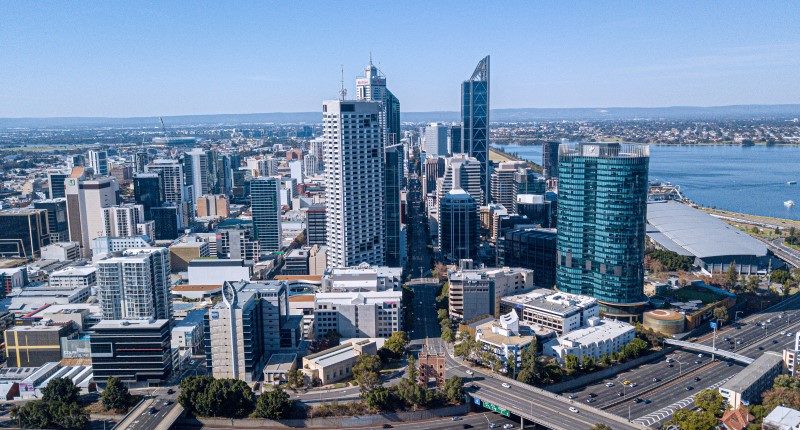- Last year, Perth house prices rose by 13.1%
- Many factors have caused this - but which are passing fads, and which are long term?
- The AICC (WA) and The Agency are hosting a free webinar on Friday delving into this question
Without a doubt, 2021 was one of the strongest years ever experienced by the Perth property market.
Despite the international – and for most of the year the domestic – borders being closed, Perth property prices continued to climb to levels not seen since the last housing cycle peak back in 2014.
In 2021, Perth house prices rose by 13.1% according to CoreLogic, reaching a median price of $520,000.
To put this into context, however, Sydney witnessed 25.3% annual growth last year, with the city’s median value of $1,098,412 more than doubling Perth’s.
Perth is the most affordable capital city in the country to purchase a home, with the exception of Darwin.
While the Perth housing market showed a solid growth trajectory during the second half of 2020 and first half of 2021, the monthly pace of growth slowed sharply during the second half of last year, according to Tim Lawless of CoreLogic.
“Although the monthly pace of growth has picked up a little, Perth remains one of the softer capital city housing markets for value growth,” Mr Lawless told The Property Tribune.
“Between July and December, 2020 Perth housing values were up 6.9%, followed by an 11.2% gain over the next six months to June 2021. The second half of 2021 saw Perth housing values rise by only 1.7%.”
“Closed state borders appear to have had a significant impact on housing demand, especially interstate migration rates.”
“The housing growth trajectory lines up well with demographic data from the ABS which shows net interstate migration moving sharply into positive territory through the second half of 2021 before dropping sharply into Q2 2021. “
Tim Lawless, CoreLogic Head of Research

Mr Lawless added there was a range of other macro factors that broadly affected Perth housing market conditions.
“Low mortgage rates, a healthy level of housing affordability following the long running downturn, low advertised stock levels and a turn to positive sentiment are also factors that have supported the Perth market.”
According to the Real Estate Institute of Australia, the average Western Australian homeowner spends 26.5% of their income on loan repayments – in New South Wales and Victoria, this figure climbs to 43.9% and 35.6% respectively.
Investors also returned to the scene last year. Perth’s relative affordability in conjunction with stronger rents saw a 108% rise in enquiries from interstate investors according to Jennifer Wakeman of Momentum Wealth.
“Investors looking towards Perth are not only benefiting from more affordable entry into the market, they are also getting more for their budget in terms of land value, property size and proximity to the CBD – all key drivers of capital and rental growth,” Ms Wakeman explained.
Housing investment was trending down across WA between 2014 and 2020 as investors sought other markets offering better returns, according to Mr Lawless.
Despite an improvement in recent times, investors remain a relatively small component of housing demand in WA.
“According to ABS lending data, investors comprised just 22% of the value of WA home lending in January, up from a recent low of 14% in late 2020, but still the lowest proportion of investment activity across the states and territories,” said Mr Lawless.
“There is a good chance the uncertainty associated with closed borders and the low rates of growth in housing prices have been a factor in the low level of investment activity.”
What’s in store for 2022?
Much like 2021, 2022 is expected to be another fast moving market for Perth. The Real Estate Institute of WA (REIWA) predicts 10% growth in the Perth median price.
With borders opening, WA will be hit with a new wave of housing demand from interstate.
Job vacancies remain high, with many employers longing for talent from the eastern states and overseas.
Although the City of Perth and commercial landlords are encouraging workers and businesses to return to the CBD, many are continuing to work from home or adopting a hybrid model.
Paul Niardone of The Agency added that while WA has lagged behind the other states in terms of price growth, strong growth is expected to occur given as borders open.
“We have seen strong interest in residential property market, off back of low interest rates, low unemployment figures and a relatively strong economy,” he told The Property Tribune.
But which of these factors are passing events and which are long term?
As an investor, it is a critical skill to identify cyclical movements from a trend, particularly in a fast moving market such as this.
Join us on Friday, March 11, as the Australia Israel Chamber of Commerce, in partnership with The Agency, facilitate a free webinar to explore the state of affairs in Western Australian property.
Hear unique insights into the WA real estate market, provided by two leading property experts, Mr Lawless and Gavin Hegney.
Afterwards, attendees are invited to participate in an interactive Q&A section.
To register, click here.
~~
To read commentary for the other capital cities, check out the below articles:
Melbourne Property Market Predictions
Canberra Property Market Predictions
Brisbane Property Market Predictions
Darwin Property Market Predictions
Sydney Property Market Predictions
Gold Coast Property Market Predictions








